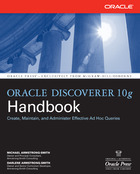Hi everyone
The long and eagerly awaited release of Discoverer 11g has just been announced by Oracle and it is available for download right now. This new version of Discoverer is now part of Oracle Fusion Middleware 11g.
Here is a (
link) to the software download. Scroll down to the section entitled Portal, Forms, reports and Discoverer and click on the appropriate link(s) for your platform. The download is beigger than you have been used to.
Here is a (
link) to the documentation download.
My good friend Abhinav, who runs the Oracle BI Blog and was the techincal editor for the Discoverer 10g Handbook, has more information available (
link). Please pay close attention to Abhinav's comments regarding the order for installing the software.
My friend, Mark Rittman, who also runs a blog and wrote the OLAP chapter in the Discoverer 10g Handbook, has further information (
link) including some screenshots.
Here are some important notes for you to consider:
- Currently the software is only available for the Microsoft Windows and Unix x86 platforms. The other operating systems as well as the 64-bit versions will be available soon
- The OC4J engine that we have all got used to has been dispensed with and replaced with the WebLogic Server, otherwise known as WLS. Get used to this acronym as it will soon become common place within the Discoverer environment
- From 11g, Discoverer is still available as a stand-alone install but the install is done from a single interface. If you want to use the full-blown install there is now a single install instead of the two as there are with 10g.
I will be making more postings in the coming months as we all come up to speed on the new version.
One thing to note, as far as I know at this stage, is that once up and running the functionality of Discoverer 11g is virtually the same as the later versions of Discoverer 10g. I am not sure which cumulative patch it is equivalent to but as soon as I find out I will let you know.






